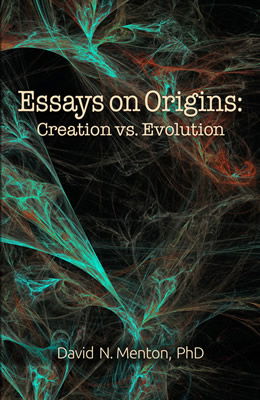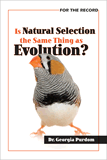
Darwin Didn’t Discover Evolution or Natural Selection
Editor’s Note: First published in St. Louis MetroVoice 5, no. 7 (July 1995).
Charles Darwin is often portrayed as one of the greatest original thinkers of science, on a par with the likes of Newton. While his book On the Origin of Species has probably had a greater impact on society than any other book—except the Bible—most of the evolutionary views he expressed in On the Origin of Species were neither original nor scientific, but rather had their roots in Pagan materialism. The essential “Darwinian” axiom of chance evolution by random change and “survival of the fittest” was broadly suggested by ancient Greek philosophers. Even the more refined concept of “natural selection,” which is often viewed as a unique contribution of Darwin, was clearly expressed by many others as early as 100 years before the 1859 publication of Origin of Species.
The French astronomer and mathematician Pierre de Maupertuis (1698–1759) is generally credited with being among the first to have developed an essentially modern theory of evolution, which included a process of random change (mutation) and natural selection. In his book Essaie de Cosmologie he said,
Chance, one might say, turned out a vast number of individuals; a small proportion of these were organized in such a manner that the animals’ organs could satisfy their needs. A much greater number showed neither adaptation nor order; these last have all perished. Thus the species which we see today are but a small part of all those that a blind destiny has produced.
Maupertuis was a very outspoken atheist who used his evolutionary speculation involving “blind destiny” and “chance” in an attempt to refute the necessity for a sovereign God and purposeful design in nature.
Charles Darwin’s ideas on evolution were anticipated in nearly every essential detail by several of his predecessors, including his own grandfather, Erasmus Darwin (1731–1802)—a fact which Charles Darwin was loath to acknowledge. Erasmus Darwin was a very highly regarded physician and one of a group of intellectuals whose writings helped to usher in the Industrial Revolution in England. A true “renaissance man,” Erasmus Darwin was a talented poet and made important discoveries in many fields including medicine, physics, meteorology, horticulture and botany. Some of his books (even on highly technical subjects) were written entirely in poetry! In 1794 and 1797, Erasmus Darwin published a two-volume work titled Zoonomia (subtitled The Laws of Organic Life) in which he speculated on the chance evolution of all life by a purely materialistic mechanism involving adaptation through natural selection. Charles Darwin’s notebooks reveal how heavily his own speculations on evolution were influenced by those of his grandfather. Yet in what must surely be one of the most self-serving examples of “the pot calling the kettle black,” Charles Darwin sought to diminish the importance of his grandfather’s evolutionary speculations as expressed in Zoonomia by declaring, “I was much disappointed; the proportion of speculation being so large to the facts given.”
Not all of those who commented on natural selection before Darwin did so from an openly atheistic or even evolutionary point of view.
It should be recognized that not all of those who commented on natural selection before Darwin did so from an openly atheistic or even evolutionary point of view. Indeed, natural selection is an observable phenomenon that is entirely compatible with a literal interpretation of biblical Creation. Natural selection simply means that the natural variation which exists among the individuals of a species will render some individuals better suited to survive (and reproduce) under particular environmental circumstances than others of the same species. Thus, heavily furred mammals might survive a particularly cold winter better than the more lightly furred members of their own species. In a similar manner, a dog breeder might use “artificial selection” to select for dogs that are well suited for the particular demands of sheep herding or duck hunting. The important point is that in neither natural nor artificial selection is it possible to select for traits that are not already in the genes of the species.
The problem for the early evolutionists, who knew nothing about genetics, was the actual mechanism that produced the inherited variability required for natural selection to work. An even bigger problem—though not generally recognized by early evolutionists—was the biological source of fundamentally new traits that were not previously in the genes of the species. Jean Baptiste de Lamarck (1744–1829) was a bitterly anti-Christian zoologist who in 1809 proposed two principles that purported to explain the source of the variation that led to new and useful structures in living organisms. The first of these—called the “law of use and disuse”—proposed that new organs (or modification of old ones) arise spontaneously through need satisfied by “use” and, accordingly, disappear through “disuse.” The second—called the “law of inheritance of acquired characteristics”—proposed that physical characteristics acquired by “use” are passed on to offspring. These so-called “laws” are perhaps best illustrated by the popular example of the giraffe’s neck. According to Lamarck, the giraffe once had a neck no longer than that of a zebra, but as the early giraffes stretched their necks to feed from the highest limbs of a tree, their necks got longer and longer (as a result of use based on need). This acquired trait was then presumably passed on to subsequent generations of giraffes who would be born with long necks.
It is now well known that the kind of physical characteristics we acquire by the use of our body, such as the development of large muscles through exercise, cannot be passed on to our offspring. This obvious fact was known even in Darwin’s time. August Weissman actually bothered to test the “law” of the inheritance of acquired characters by cutting off the tails of 57 generations of mice. It should have surprised no one that even after bobbing the tails of 57 generations of mice, none were ever born without tails. Still, Darwin had no better explanation for genetic variability and was ambivalent about Lamarck’s “laws,” which he variously praised and condemned.
Today, evolutionists tell us a different legend of how the giraffe got its long neck. They relate how some giraffes just happened to develop long necks through a fortuitous string of chance mutations that had nothing to do with need or use. Those giraffes with long necks just happened to find them beneficial because they were able to feed on the foliage of the taller trees, while those with shorter necks could not. This, according to evolutionary dogma, eventually resulted in the disappearance of giraffes with shorter necks who either died from starvation or as a result of their poor state of nutrition left fewer offspring. What this new legend doesn’t explain is how female giraffes have managed to survive given that their necks are on average a full foot shorter than those of the males. Still, for many evolutionists who reject the very idea of a supernatural Creator, the mere ability to conceive of such materialistic legends or scenarios appears to suffice as a “scientific” explanation.
While many of those who anticipated Darwin’s ideas on evolution were atheists, anti-Christians, and even involved in the occult (like Alfred Russel Wallace), perhaps the unkindest cut of all for Darwin was that even some Creationists wrote in great detail about natural selection prior to his publication of On the Origin of Species. Indeed, Creationists such as British theologian William Paley and the British chemist Edward Blyth had a far more scientifically tenable view of the biological significance of natural selection than Darwin. Like other Creationists, both Paley and Blyth saw natural selection as a mechanism for eliminating unfit individuals that differed from the created type. Thus, while Darwin preferred to believe that the elimination of unfit individuals was a mechanism for somehow evolving new and improved species, the Creationists saw elimination of unfit individuals as mechanism to preserve the stability of existing Created kinds.
Readers may wish to compare the plausibility of the Creationist and evolutionist views of natural selection as follows: First, think of several actual examples from nature where a normal existing animal species is sustained by the elimination of abnormal individuals. No problem! Now, try to think of a single occurrence in nature where a fundamentally new and improved animal species has been formed by the elimination of the normal in favor of the abnormal. Darwin couldn’t think of any either!
Essays on Origins: Creation vs. Evolution
Recommended Resources

Answers in Genesis is an apologetics ministry, dedicated to helping Christians defend their faith and proclaim the good news of Jesus Christ.
- Customer Service 800.778.3390
- Available Monday–Friday | 9 AM–5 PM ET
- © 2025 Answers in Genesis


